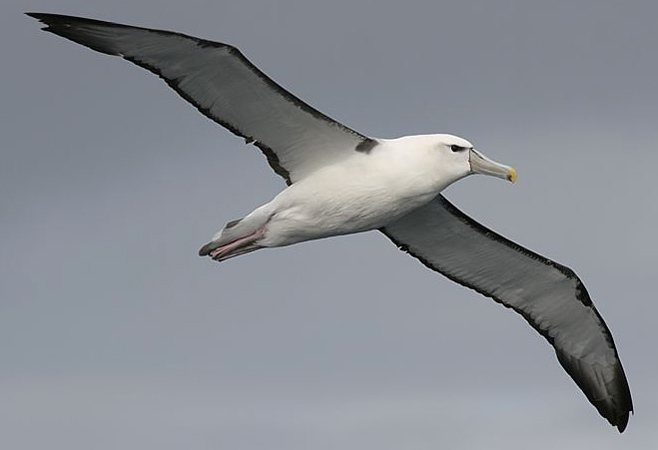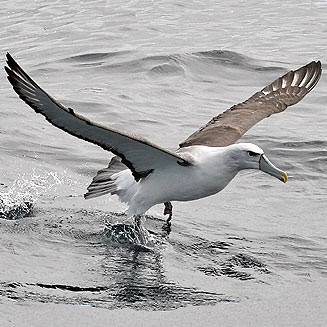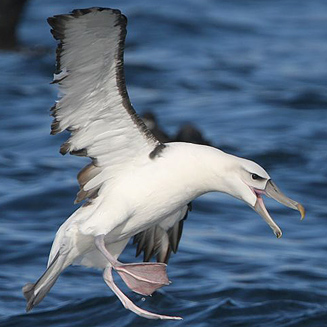|
Thalassarche cauta (Shy
albatross)
[= Diomedea cauta]
Bloubekalbatros [Afrikaans]; Bloubekmalmok [Afrikaans];
Witkapalbatros [Dutch]; Albatros à cape blanche [French]; Scheuer
albatroß [German]; Albatroz-arisco [Portuguese]
Life
> Eukaryotes >
Opisthokonta
> Metazoa (animals) >
Bilateria >
Deuterostomia > Chordata >
Craniata > Vertebrata (vertebrates) > Gnathostomata (jawed
vertebrates) > Teleostomi (teleost fish) > Osteichthyes (bony fish) > Class:
Sarcopterygii (lobe-finned
fish) > Stegocephalia (terrestrial
vertebrates) > Tetrapoda
(four-legged vertebrates) > Reptiliomorpha > Amniota >
Reptilia (reptiles) >
Romeriida > Diapsida > Archosauromorpha > Archosauria >
Dinosauria
(dinosaurs) > Saurischia > Theropoda (bipedal predatory dinosaurs) >
Coelurosauria > Maniraptora > Aves
(birds) > Order: Ciconiiformes
> Family: Diomedeidae
 |
|
Adult Shy albatross, offshore from Cape Town, South Africa. [photo
Trevor Hardaker ©] |
 |
 |
|
Adult Shy albatross, offshore from Cape Town,
South Africa.
[photo
Jeff Poklen
©] |
Adult Shy albatross, offshore from Cape Town, South Africa. [photo Trevor Hardaker ©] |
Distribution and habitat
Breeds on islands off New Zealand and Tasmania, dispersing
across the southern Indian Ocean to southern African waters, where it is
especially common off the southern and western coast of South Africa and
Namibia. It generally prefers water on the continental shelf, while more scarce
further out in the ocean.
Movements and migrations
The first fully fledged juveniles arrive off
the Eastern Cape in August, moving to the Western Cape in about a
month.
Food
It does both hunting and scavenging, mainly feeding on
pelagic schooling fish and offal and bycatch from fishing vessels, supplemented
with crustaceans and squid. It often forages in association with other animals. The following food items have been recorded
in its diet:
- fish
- Engraulis encrasicolus (Anchovies)
- Sardinops sagax (Sardines)
- Etrumeus whiteheadi (Round herrings)
- Trachurus trachurus (Horse mackerel)
- Scomberesox saurus (Sauries)
- crustaceans
- squid
- Ommastrephes bartramii (flying squid)
Threats
Near-threatened, with a world population of
approximately 400 000-420 000 individuals. Its main threat is longline fishing,
which for example killed an estimated 5000-10 000 birds off southern Africa
between 1999 and 2000.
References
-
Hockey PAR, Dean WRJ and Ryan PG 2005. Roberts
- Birds of southern Africa, VIIth ed. The Trustees of the John Voelcker
Bird Book Fund, Cape Town.
|
